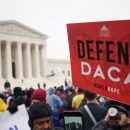Proposal offers separate paths for legal status, work eligibility; Immigration groups fear backlogs, employer confusion.
By Andrew Kreighbaum | Bloomberg Law | FEB. 11, 2022
- Proposal offers separate paths for legal status, work eligibility
- Immigration groups fear backlogs, employer confusion
As the Biden administration puts the finishing touches on final regulations to protect young undocumented people from deportation, immigration groups are urging it to change course on a draft rule’s decoupling of work authorization.
The Department of Homeland Security released its proposed rule in September, codifying the Obama-era Deferred Action for Childhood Arrivals program, which shields so-called “Dreamers” from removal and allows them to work legally in the U.S.
Supporters hope the final regulations will fortify DACA’s legal standing in the wake of a federal judge’s ruling last year that the original program was illegal. Immigration advocates have also backed the rulemaking process while calling for Congress to separately pass permanent relief for Dreamers.
But those backing DACA have also raised concerns in public comments on the draft rule’s proposal to make applications for work authorization optional, a marked departure from the original, which required deferred action applicants to request work authorization at the same time.
DHS argued in its draft rule that the proposed move would be a “modest change” that could save some DACA participants, such as full-time students, costs on fees. But immigration advocates say splitting off work eligibility applications could lead to DACA recipients getting caught in bureaucratic backlogs and raises the risk that employment authorization is eliminated entirely by future administrations less committed to the program.
“We don’t believe those two issues are separate. The ability of dreamers to freely integrate themselves into this country is synonymous with their ability to work here,” said Marissa Molina, the Colorado state immigration director at the immigration advocacy group FWD.us. “We really do see that as a pretty big red flag.”
DHS declined to comment further on the proposed rule.
Legal experts say that the approach to work eligibility is part of the Biden administration’s larger effort to shield the program from future court challenges.
“Advocates obviously would like it to be just an automatic grant” of work eligibility, said Muzaffar Chishti, a senior fellow at the Migration Policy Institute. “They have decided to go a different route because they think that’s more legally defensible.”
Legal Challenges
President Barack Obama’s administration established the DACA program in 2012 via a secretarial memo. Immigrants younger than age 16 when they arrived in the U.S.—who have been in the country since 2007, completed a high school degree or the equivalent, and had not been convicted of a felony or serious misdemeanor—were allowed to apply for protection from deportation under the program. DACA applicants were also required to submit an application for employment authorization at the same time so they could receive a work permit.
A decision by the Trump administration to rescind the DACA program was blocked by the U.S. Supreme Court in 2020, but it’s continued to be targeted in legal actions by Republican-led states.
In response to a lawsuit led by Texas, U.S. District Judge Andrew Hanen declared the program unlawful in a decision last year because it never went through a formal rulemaking process. Hanen’s ruling, which the government is appealing, blocked Homeland Security from processing new applications. But it kept protections in place, for now, for the more than 600,000 current participants and left the door open for the Biden administration to issue DACA regulations for the first time.
Texas and eight other states filed a brief this week asking the New Orleans-based U.S. Court of Appeals for the Fifth Circuit to affirm Hanen’s decision declaring DACA unlawful. Oral arguments have not been scheduled for the appeal.
Hanen “made it clear he was giving the Biden administration the opportunity to address problems he identified with DACA as it was put in place,” said Laurence Benenson, vice president for policy and advocacy at the National Immigration Forum.
There’s longstanding acceptance that presidential administrations have discretion in how they carry out immigration enforcement, Benenson said. But courts may look more skeptically on broad grants of work authorization, he said.
Organizations including the U.S. Chamber of Commerce and the American Council on Education, the chief lobby group for U.S. colleges, have warned about the implications of splitting off work eligibility from deferred action.
“We heard from institutions and we heard from students that the work authorization portion is really important and that it made more sense to keep them together and make this less complicated,” said Sarah Spreitzer, assistant vice president and chief of staff for government relations at ACE.
‘Defensive Strategy’
Beyond the potential confusion caused by allowing separate applications for work eligibility, Molina of FWD.us said massive backlogs at U.S. Citizenship and Immigration Services raise the possibility of DACA recipients waiting months for work eligibility.
The organization also urged the Biden administration to extend work authorization to three years under the DACA rule and to expand eligibility to roughly 620,000 K-12 age children who were too young to qualify for the original program.
But the administration, expecting further court challenges to the program, appears to be limiting itself to shoring up existing protections, said Chishti of the Migration Policy Institute.
“They’re more in a defensive strategy than an expansive strategy,” he said.






